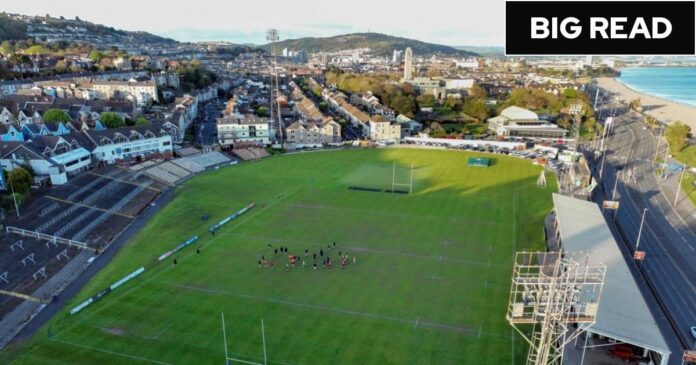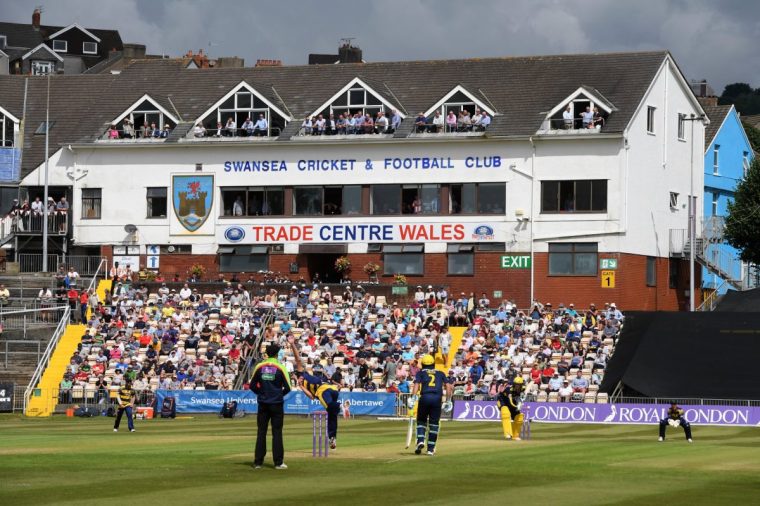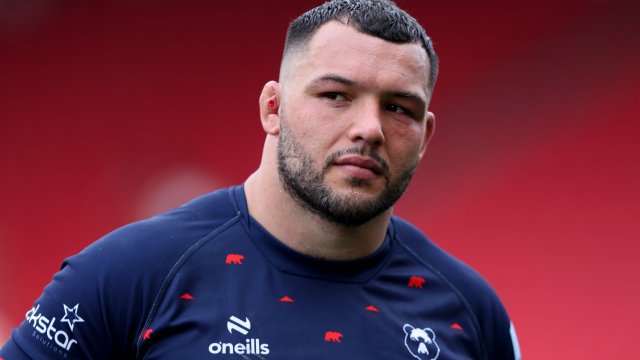
[ad_1]
They have both pictured the scene, the Ospreys supporter and the chief executive: a camera drone soars and swoops over the new stadium at St Helen’s, a year from now when the alterations are finished and this has become the team’s home once more – the same but different to their old one.
It might be the best location of any rugby ground, looking out over the beach and the bay, says Lance Bradley, the Ospreys’ CEO.
Meanwhile, vice-chair of the supporters’ club Grant Berni enthuses: “I’m sure the TV pictures are going to look fantastic. Supporters are really positive to the point that if St Helen’s was ready now, people would be happy to move there straight away.”
Anyone who has seen the same view of the sweep of the sandy beach of Swansea Bay, west to the geographical bookend of the Mumbles headland, will vouch for both its beauty and its place in Welsh sporting history.
Read Next
This move for Ospreys out of the Swansea.com (former Liberty) Stadium, into a venue with new stands and a 3G pitch that will take 12 weeks to lay in the late summer of 2025, reeks with nostalgia, but also the hope of security for a part of rugby’s ecosystem facing financial trouble.
“On the pitch, we’re in really good shape,” says Bradley, fully aware this statement is relative, given the lack of impact made by all four Welsh regions at the highest levels in recent years.
“We qualified for the knockouts of both the competitions that we were in, last season, and given the constraints we were working under, that was a pretty good performance.
“We’ve got a better squad this year, and our academy is in fantastic shape, and there are things we know we can do to make it even better.
“So that’s all positive, but you need to get people watching it, and to get people watching, it needs to be a great atmosphere. Moving to St Helen’s will give us that atmosphere, and we think a lot more people will get behind the club.”
The new-old stadium will have a capacity of around 8,000, not the 21,000 of the Swansea.com, on the other side of the city, where Ospreys’ fans enjoy the “luxury”, as Berni puts it, of “facilities, parking, everything undercover”, but rattle around when it is less than half full for most matches.
The broad, open aspect of St Helen’s – a ground also used by Swansea Cricket Club – will be altered and hemmed in for rugby by aligning the pitch with the terrace, which will stay but be given a rain-proof roof.
 St Helen’s also hosts cricket – for now (Photo: Getty)
St Helen’s also hosts cricket – for now (Photo: Getty)
That is similar to the famous Shed at Gloucester, where Bradley used to work, while the main metal stand is moved round behind the Mumbles end, another stand erected at the “town” end, and a main stand for the seaside road side.
Bradley says it will be reminiscent of The Hive used by Edinburgh next to Murrayfield.
“I know the players are looking forward to having somewhere that’s ours,” says Bradley. “We’re even thinking about, when we move the pitch, do we move it not quite parallel to the terrace, so when the kicker’s lining up his kick, our kicker knows it’s not quite parallel, and the away kicker won’t.”
This is the fun of it; the hwyl of a home weekend to look forward to. Berni says: “We want supporters to help turn it into a fortress again, back in the old days of that intimidating, rugby club type atmosphere.”
Read Next

Ospreys have had a taste of this lately by temporarily playing at Bridgend’s tightly-packed Brewery Field. But Swansea, without rehashing all the arguments since “Ospreylia” was launched just over 20 years ago, is the heart of the operation.
A lucrative stadium naming rights will follow, says Bradley, likely to be phrased as “the X stadium at St Helen’s”.
Ospreys will own and operate the stadium with a long lease on the council-owned land, with Swansea RFC, Swansea University and eventually an elite women’s team also playing rugby there.
Big screens will show Six Nations matches. The benefits of keeping food-and-beverage revenue, and putting on fireworks shows and other events, will accrue.
All sound good? But wait, what about those noises off? The rumbling rancour that seems forever part of Welsh rugby, although maybe less so during the far-off amateur days when, as the 1980 book Fields of Praise noted: “The Swansea [Rugby] Football Club grew out of the local cricket club; it was cricketers who converted some sandhills within a drop-kick of Swansea Bay into an eight acre enclosure that became the circus maximus of the west, St Helen’s.”
This was where, in 1968, Garry Sobers, playing for Nottinghamshire against Glamorgan, hit six sixes off Malcolm Nash. And the “All Whites” of Swansea RFC became the first club side to defeat the southern-hemisphere big three: Australia in 1908, South Africa in 1912 and New Zealand in 1935.
Wales played home internationals with crowds of 50,000, when crushes outside the ground were common, and traffic along the A48 past Port Talbot legendarily grim.
On a misty day in November 1992, a Swansea team including Richard Moriarty, Robert Jones and Scott Gibbs beat Australia’s world champions 21-6 in front of 10,000.
A more recent visit by Barbarians, that was also a farewell to Ospreys and Wales great Alun Wyn Jones, had writer and historian Huw Richards hailing “the brightly-painted backs of houses in Bryn Road, with crystal blue sky above the Townhill skyline; a chance to relax, to briefly escape the political and economic ills of rugby union in Wales”.
Read Next

Now, the renovation plans sit alongside the hot topic of debt held by the Welsh Rugby Union and the regions, some of it from Covid survival loans, and the plan for eventually £6.4m for each of the regions to spend on their squads.
There is talk of the WRU, under a new chief executive in Abi Tierney, taking on more of the debt burden, and also a controversial 20 per cent stake in each region.
i‘s understanding from various sources is that this would include scope for Warren Gatland, the head coach of the national team who are on a run of nine Test losses, to give an opinion on where a player should be playing – region-wise and positionally.
Logically, this would be more likely to happen earlier in a career. Could a region’s senior player be shifted from one region to another, involuntarily? He would be unlikely to reach Test standard at the same time as two or three other Test-quality players in his position in the same region, while a neighbouring region had none. Still, it is all very contentious.
Bradley refuses to comment on specific aspects. He is in favour of a more collaborative approach, and the watchword would be cooperation, not control. “We are in discussions,” he says. “I feel really positive about it and I do think it’s going to have a positive impact.”
For Berni’s part, he says fellow supporters are “furious” about the notion of WRU control. “The WRU haven’t got the greatest history in how they have done things over the last few years. Now they are trying to fix it, but they don’t have a great track record.”
Coaching-wise, Ospreys are in the unusual position of having announced the departure of Toby Booth, the boss since mid-2020, for the end of this season – or earlier if the highly-experienced Englishman finds another position – with former Wales wing Mark Jones promoted to take charge, and flanker Justin Tipuric becoming defence coach.
 Ospreys will soon have a new home (Photo: Getty)
Ospreys will soon have a new home (Photo: Getty)
Booth tells i the speculation over the WRU having a say in regions’ executive and coaching appointments is not linked to his move.
He also says: “There are some good players in this country, without doubt, and there are some good youngsters, but the structures and processes have got to get them into the right programmes as early as possible, in order to not get the blips.
“The golden era is finished. We’ve got to make the next golden era, but also make it an era that then becomes self perpetuating. So you’ve got to have the right people controlling the processes, and they have to be joined up instead of just being in silos. Because if not, you find yourself scratching around looking for players, and at international level, you shouldn’t be doing that.
“Clarity and alignment are critical, and this has to be delivered by competent people with empathy and mutual understanding to invoke trust towards a common goal.”
Other issues swirl around like the wind over Swansea Bay: what to do about the URC and the South African teams; Bradley knows supporters who would like to see more matches with Gloucester, Bristol and Bath.
And Berni says: “We are playing in a league where chances are you’ve got to jump on a plane to go watch a game. Personally, I’m all for the Anglo-Welsh. Playing against English sides, a different world.”
Read Next

As for St Helen’s, Berni recalls the Ospreys of Gavin Henson and company there in the mid-noughties and says: “My main memory was the chaos on a windy day, someone would put up an up-and-under on the halfway line, and the ball would land behind them on the cricket square.
“The fact they are closing it in, putting a roof on and the rest, will really help the atmosphere. A smaller stadium with a big terrace and limited seating will get people thinking ‘I need to get a season ticket’, and they might invest a bit more. Or people might just go and stand in the terrace and enjoy the social side of it.”
Bradley says: “TV revenue is static and it is also completely outside our control, and it’s really dangerous running a business where the major part of your income is outside your control. So you have to build up your other revenue – tickets and sponsorship and non-matchday.
“It’s £95 to sit on the halfway line at Bath. I am not suggesting we get to quite that level. But, you know, Edinburgh managed to get their best seats up from around £25 to £45.
“That’s a really big difference, and there are people around in and around Swansea who don’t mind paying £45, £50 for the best seats, but they do have to be the best seats, and it has to be a good atmosphere.
“Our players love playing at the Swansea.com but, unfortunately, so do the opposition, because it’s Premier League quality throughout. You always want to welcome your opponents, but you also want them to look at the fixture list and think ‘oh God, I’ve got to go to Ospreys on Saturday’ and have that little bit of ‘it’s always intimidating there’, and to know you’re going to have a tough time.”
[ad_2]
Copyright for syndicated content belongs to the linked Source link

